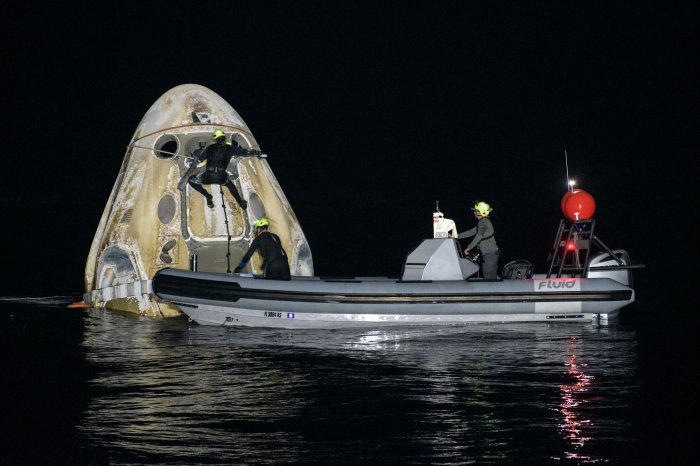1 of 5 | SpaceX launches a satellite for Iridium in January 2019 from Vandenberg Air Force Base in California. Photo courtesy of SpaceX |
License Photo
ORLANDO, Fla., June 1 (UPI) -- The state of California and Vandenberg Space Force Base are planning and building new infrastructure to capture more of the growing commercial space launch business.
Vandenberg has never been as busy as the primary U.S. spaceports in Florida -- Kennedy Space Center and Cape Canaveral Space Force Station. But now SpaceX and several other launch companies plan to increase activity on the launch pads overlooking the Pacific Ocean.
SpaceX will begin launching the company's Starlink satellites toward polar orbits from Vandenberg soon, Col. Anthony Mastalir, commander of Vandenberg's launch range and personnel, said in an interview.
"Just within the last couple of months, we've seen SpaceX put half a dozen Falcon 9 launches on the manifest to complete their Starlink constellation and hit the higher orbits they need to hit," Mastalir said.
New companies have joined the nation's two largest launchers, SpaceX and United Launch Alliance, in leasing dedicated launch pads at Vandenberg. And there are dozens of former launch pads that could still be renovated, Mastalir said.
The recent reorganization of Cape Canaveral and Vandenberg under the new U.S. Space Force also means great coordination of launches nationally, he said.
Texas-based Firefly Aerospace has renovated a pad where it plans to launch the new Firefly Alpha rocket for the first time this summer.
Los Angeles-based Relativity Space also plans launches there, and just received $30 million in tax credits from the state, partly to create jobs and invest in launch infrastructure at Vandenberg.
The polar orbit is a major attraction for the West Coast launch sites, as companies like OneWeb and SpaceX deploy thousands of new broadband communication satellites, Mastalir said.
Satellites on a polar orbit, rather than equatorial, can be launched southward safely over the ocean from Vandenberg, which is why the U.S. government has launched missile tests and rockets from there historically. Polar launches are possible in Florida, but the geography isn't as well-suited.
The military unit Mastalir commands, Space Launch Delta 30, has signed a memorandum of understanding with the state of California, Santa Barbara County and several colleges to collaborate on growth in space business around Vandenberg.
"Vandenberg is 100,000 acres, right, so I have a lot of property that can be used to kind of develop the space industry," Mastalir said.
Vandenberg has started an environmental assessment to prepare for possible new growth that would help streamline state permitting in the future, he said. The base also plans to add new high-speed, fiber communications in the relatively undeveloped southern half of the base.
Relativity and Firefly plan to hire dozens of people in the region soon, said Andrew Hackleman, chief operating officer at REACH Central Coast, a regional non-profit coalition that promotes higher-paying jobs near Vandenberg.
"We're developing a master plan so we can seek state and federal funding for more infrastructure to expand the launch capability, like roads, propellant rocket fuel storage and power connections," Hackleman said.
"We have detailed launch forecasts that show big increases in the next decade, and we are trying to get ready for that," he said. The group has studied how Space Florida, the state's development agency for space in Florida, organized new growth around Kennedy Space Center.
Meanwhile, Firefly is seeking final permits and lease arrangements ahead of its first Alpha test-firing, said Robb Kulin, chief engineer on the Alpha rocket.
"There's a lot of negative regulatory carryover from previous ways of doing things with launch permitting in general but also with environmental regulations," Kulin said in an interview.
"A lot of those regulations were written with the procurement concept in mind, meaning when only the Air Force and NASA launched rockets," Kulin said.
The COVID-19 pandemic and other delays resulted in a slow launch pace in 2020, but the base anticipates a dozen launches this year. Eventually, Mastalir said, he expects to see 50 launches per year, which is more like the pace of activity in Florida.
"If we're not postured to do 50 launches a year over the next 10 years, then we've failed. So all of our efforts are designed to accommodate 50," Mastalir said.
Support teams work around the SpaceX Crew Dragon Resilience spacecraft shortly after it landed with NASA astronauts Mike Hopkins, Shannon Walker and Victor Glover and Japan Aerospace Exploration Agency astronaut Soichi Noguchi aboard in the Gulf of Mexico off Panama City, Fla., on Sunday. Photo by Bill Ingalls/NASA |
License Photo
















